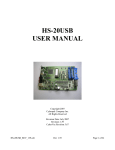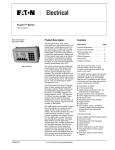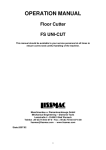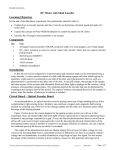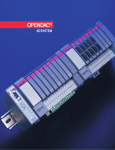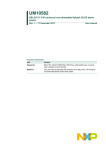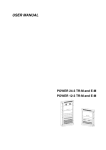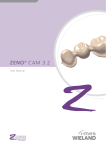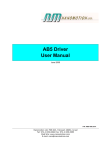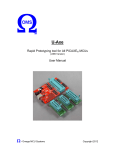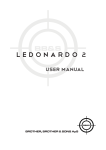Download CY-41, CY-42 Bipolar Full/Half Step Motor Driver
Transcript
CY-41, CY-42 Bipolar Full/Half Step Motor Driver Modules User’s Manual Copyright CyberPak Co. 1999/2000 Manual Revision 1.32 CY-41 and CY-42 Modules Note: Bottom mounting flange accessory is available on either model. Revision 1.31 Page 1 CY-41 and CY-42 User’s Manual Overview – How Are They Different From Each Other There are at this time three products in the CY-40 module family. All of the modules are the same size and mounting footprint and share many features in common. CY-40 (not recommended for new designs) • This is the base product similar to other products on the market. This product will not be enhanced since some customers using similar products want a second source with as few changes as possible. In many cases however, you may be able to improve your product by using the enhanced members of this family of products. • CY-40 uses the sinking type interface. CY-41 ONLY • The CY-41 has a low power mode feature which engages about ¾ to 1 second after the last step pulse it receives. It then reduces to about 50%-60% of its programmed current. In volume OEM orders it may be possible to accommodate custom specification of either the low power percentage or the time to low power. • The CY-41 uses a special circuit technique to increase the running efficiency as compared to the CY-40. • The CY-41 uses the sinking type interface CY-42 ONLY • The CY-42 runs on AC power. All you need is a transformer AC secondary of about 24 volts, up to about 30 VAC max. The rest of the power supply is built into the CY-42 driver itself. • The CY-42 also has a low power mode feature which engages about ¼ second after the last step pulse it receives. It then reduces to about 50%-60% of its programmed current. In OEM orders it may be possible to accommodate custom specification of either the low power percentage or the time to low power. • The CY-42 uses a special circuit technique to increase the running efficiency as compared to the CY-40. • The CY-42 uses a sourcing type interface. • The CY-42 also has opposite levels for most interface signals due to the sourcing connection (see CY-42 Logic Interface Connector Pin-Out (page 5) Features Common to the CY-40, CY41 and CY-42 • The product is a small bipolar chopper drive motor driver module made for OEM product use. We have gone to some extra effort to enhance your success with this product. • All input signals are opto coupled. This means that your indexer subsystem and your motor driver stage need not share a common ground. Furthermore significant over-voltage spikes on signal lines will not damage inputs. Reverse voltage spikes are tolerated without damaging to -15 volts. The inputs can be driven from a system that operates using TTL (+5 volt) logic. • The module gets its internal logic power supply from the motor power supply. The motor power supply is typically 24-35 volts unregulated DC (AC to 30 vac in the case of the CY-42). This product uses an efficient on board switchmode DC-DC converter rather than the more commonly used linear 3 terminal regulator. This means we save several watts of dissipation that would otherwise occur, Revision 1.31 Page 2 • • • which not only unburdens your power supply, but also that your driver module will run cooler or you can run higher current motors with a smaller heatsink. The modules have convenient depluggable terminal strips that make replacing modules simple. The modules have built-in short circuit protection. This serves especially the OEM customer since it is ‘forgiving’ of potential wiring errors that can occur in every shop. If you need to operate the module at current levels over 2.5 amps, you may wish to provide some additional heat sink capability (especially on the CY-40 model). In most cases this could be as simple as fastening it to your aluminum chassis or using some kind of heat sink extrusion. The CY41 and CY-42 may be run in typical applications without a heat sink, even up to 3.5 amps. Connecting Your Indexer with CY-40,CY-41,CY-42 5 4 3 2 1 Motor Connector CY-40 OR CY-41/42 Step Motor Driver Logic Interface Connector 1 2 3 4 5 6 7 8 9 10 Figure 1 Revision 1.31 Page 3 THE FOLLOWING 2 TABLES APPLY TO EITHER THE CY-40 or CY-41 Logic Interface Pin # 1 2 3 Function Run/Reset Half/Full Step In 4 5 6 7 8 9 10 CW/CCW Cir/NonCir Ena/Disable 5 VDC Current #1 Current #2 Ground Connector Pin-out Notes High or NC - Driver is ready to run - Pull Low to reset to initial phase state High or NC - Driver operates in Half Step Mode - Pull Low to operate in Full Step Mode Transition from High to Pulled Low advances Motor 1 full or half step Note: This pin must be released after pull down or the low power timeout is inhibited High defines Clockwise rotation 0 Pulled Low defines Counter-Clockwise rotation Defines current regulation mode - Normally NC High or NC permits driver to supply power to the motor - Pulled Low de-powers motor indexer supplies opto-coupler interface power Resistor Terminal #1 to program current limit to motor Resistor Terminal #2 to program current limit to motor Power ground for step motor power supply NOTE: The 7 position mating connector is provided for this 5 position connector. If an OEM prefers a 5 position connector, please contact factory. Motor Connector Pin # 1 2 3 4 5 6 7 Function + Vm Motor A1 Motor A2 Motor B1 Motor B2 Spare Spare Revision 1.31 Notes Step Motor power supply positive terminal First end of step motor phase A winding Second end of step motor phase A winding First end of step motor phase B winding Second end of step motor phase B winding You could connect extra wire from 6/8 wire motor You could connect extra wire from 6/8 wire motor Page 4 THE FOLLOWING TABLE APPLIES TO CY-42 ONLY Logic Interface Connector Pin-out (NC means no connection, not driven) Pin # 1 2 3 Function Reset/Run Full/Half Step In 4 5 6 7 8 9 10 CCW/CW Cir/NonCir Disable/Ena Sig Ground Current #1 Current #2 AC2 Notes Low or NC - Driver is ready to run - Drive high then low to reset to initial phase state Low or NC - Driver operates in Half Step Mode - Drive high to operate in Full Step Mode Transition from Low to High advances Motor 1 full or half step Note: This pin must not be held high or the low power timeout is disabled. Low defines Clockwise rotation; driven high defines Counter-Clockwise rotation Low or NC Defines current normal regulation mode - Recommend NC Low or NC permits driver to supply power to the motor - Drive high to de-power motor Indexer signal return for opto-coupler drive signals Resistor Terminal #1 to program current limit to motor Resistor Terminal #2 to program current limit to motor Other End of AC transformer (this is not a ground) NOTE: The 7 position mating connector is provided for this 5 position connector. If an OEM prefers a 5 position connector, please contact factory. Motor Connector Pin # 1 2 3 4 5 6 7 Function AC1 Motor A1 Motor A2 Motor B1 Motor B2 Spare Spare Revision 1.31 Notes First AC transformer connection (not a ground) First end of step motor phase A winding Second end of step motor phase A winding First end of step motor phase B winding Second end of step motor phase B winding You could connect extra wire from 6/8 wire motor You could connect extra wire from 6/8 wire motor Page 5 Connecting Your Motor First, determine whether your motor is a 4 wire, 6 wire or 8 wire motor. If it is any other number of wires you may wish to call the factory. Schematics are listed below for each type. To identify the connections on motors, first refer to the manufactures catalog. Usually there will be a schematic similar to that shown in one of the following diagrams with the wire colors identified. Once connected, you may find that the motor rotates in the opposite direction from that you wish it would. In that case simply exchange the A1 and A2 connection. Do not exchange the wires from both motor coils, just one coil. Four Wire Motor Figure 2 When using a 4 wire motor set the CY-40 OR CY-41 to the same current as the motor current rating. Six Wire Motors and Eight Wire Motors: Before discussing them individually, the 6 & 8 wire motors will be discussed together. CAUTION: CURRENT RATING ON MOTOR MAY NOT APPLY First of all there are several ways to connect 6 & 8 wire motors to the 4 terminal connections of the CY40 OR CY-41 BIPOLAR driver. The current rating on the motor is normally defined for a unipolar type driver and the CY-40 OR CY-41 is a bipolar driver. Please use the following table to determine the proper current level for your motor and method of connection. 6 Wire 6 Wire 8 Wire 8 Wire Revision 1.31 Figure 3 Figure 4 Figure 5 Figure 6 set CY-40 OR CY-41 to 100% of motor rating set CY-40 OR CY-41 to 70% of motor rating set CY-40 OR CY-41 to 141% of motor rating set CY-40 OR CY-41 to 70% of motor rating Page 6 Six Wire Motors: There are two ways to connect the six wire motor to your driver. Originally six wire motors were designed and manufactured for an electronic driver module type called ‘unipolar’. Unipolar drive technology is obsolete and has no advantage over bipolar. The first way to connect this motor is to use the wires that connect to one end and the center tap of the step motor coil. This may seem like an odd thing to do, but it will give the same performance out of the motor as if you were to have used the unipolar type driver. Figure 3 Center to End Connection Figure 4 End to End Connection Figure 6 Coils in Series Revision 1.31 Figure 5 Coils in Parallel Page 7 Appendix 1 POWER SUPPLY Power Switch 3-5 Amp Fuse Secondary of 24 VAC with 3 amps or more 100 Volt 5 Amp Bridge Rectifier Expect about 30 VDC unregulated + 115 VAC C1 2000 uF (or larger) 24 VDC Electrolytic Capacitor DC Ground +Volts CY-40/41 Motor Driver Ground Power Supply Example for CY-40 or CY-41 Power Switch 3 to 5 Amp Fuse Secondary of 24 VAC with 3 amps or more 115 VAC AC CY-42 Motor Driver AC Power Supply Example for CY-42 Revision 1.31 Page 8 REPLACEMENT CONNECTORS: If you order the module with the C suffix after the part number (example CY-41C) it will come with a set of terminal strip connectors. If you need an extra set you are welcome to order them from us. The standard part #’s are listed here as an alternate source. • • 10 position Terminal Block - Newark Stock # 50F3557 (Wieland #25.600.3053.0 ) 7 Position Terminal Block - Newark Stock #50F3554 (Weiland 25.600.2753.0 ) MECHANICAL MOUNTING INFORMATION: The bottom surface of the module should be mounted to a metal chassis or heat sink. The dimension of the bottom plane of the module extrusion is 3.25 x 1.5 inches. A pattern of 4 holes of 0.90 x 2.00 inches exist centered on this plane. These mounting holes are threaded for 8-32 screws. The extrusion thickness is .125 inch, so you screw can not protrude further than this into the base. We do have an insulating stop on the other side, but a strong screw driver could go through this, and that’s not fair. A recommended screw when mounting to 1/8 inch thick panel is 8-32 x 1/4 FLAT 82 DEGREE (MacMaster Carr# 91771A190). This is a Philip’s flat head screw. Revision 1.31 Page 9 Specifying the current that your driver will supply To program your driver to supply a specific current level, look up the desired current in the first column, then use the closest available value resistor to that specified in the second column. For example: You have a motor that requires 2.8 Amps. Look at the 2.8 amp value in the first column, then find the corresponding resistance in the second column; 7500 ohms. Current 0.3 0.4 0.5 0.6 0.7 0.8 0.9 1.0 1.1 1.2 1.3 1.4 1.5 1.6 1.7 1.8 1.9 2.0 2.1 2.2 2.3 2.4 2.5 2.6 2.7 2.8 2.9 3.0 3.1 3.2 3.3 3.4 3.5 Revision 1.31 Resistor 69800 56200 44200 37400 31600 27400 24300 21000 20000 18200 16200 15800 14700 13700 12700 11800 11300 10700 10200 9760 9310 8870 8450 8250 7870 7500 7320 6980 6810 6650 6340 6190 5900 Page 10 Signal Level and Timing Specifications CY-40/41 VIH VIL IIH IIL TCLK TS TH Opto+ = 5V Opto+ = 5V Opto+ = 5V, VIN = 5V Opto+ = 5V, VIN = 0V Clock Pulse Width (Rising Edge) Direction Setup Time Direction Hold Time Min 3.0V Typical Max 2.0V 0 6 mA 2.0 uS 1.0 uS 4.0 uS CY-42 VIH VIL IIH IIL TCLK TS TH Opto Ground = 0V Opto Ground = 0V Opto Ground = 0V, VIN = 5V Opto Ground = 0V, VIN = 0V Clock Pulse Width (Falling Edge) Direction Setup Time Direction Hold Time Min 3.0 V Typical Max 2.0 V 6 mA 0 2.0 uS 1.0 uS 4.0 uS CY-40/41 Step CY-42 Step CW/CCW Half/Full TS T CLK TH CY-42 Test Circuit CY-40/41 Test Circuit 5VDC Opto+ ( 7 ) - - Input Under Test + Input Under Test Revision 1.31 + Opto Gnd ( 7 ) Page 11











